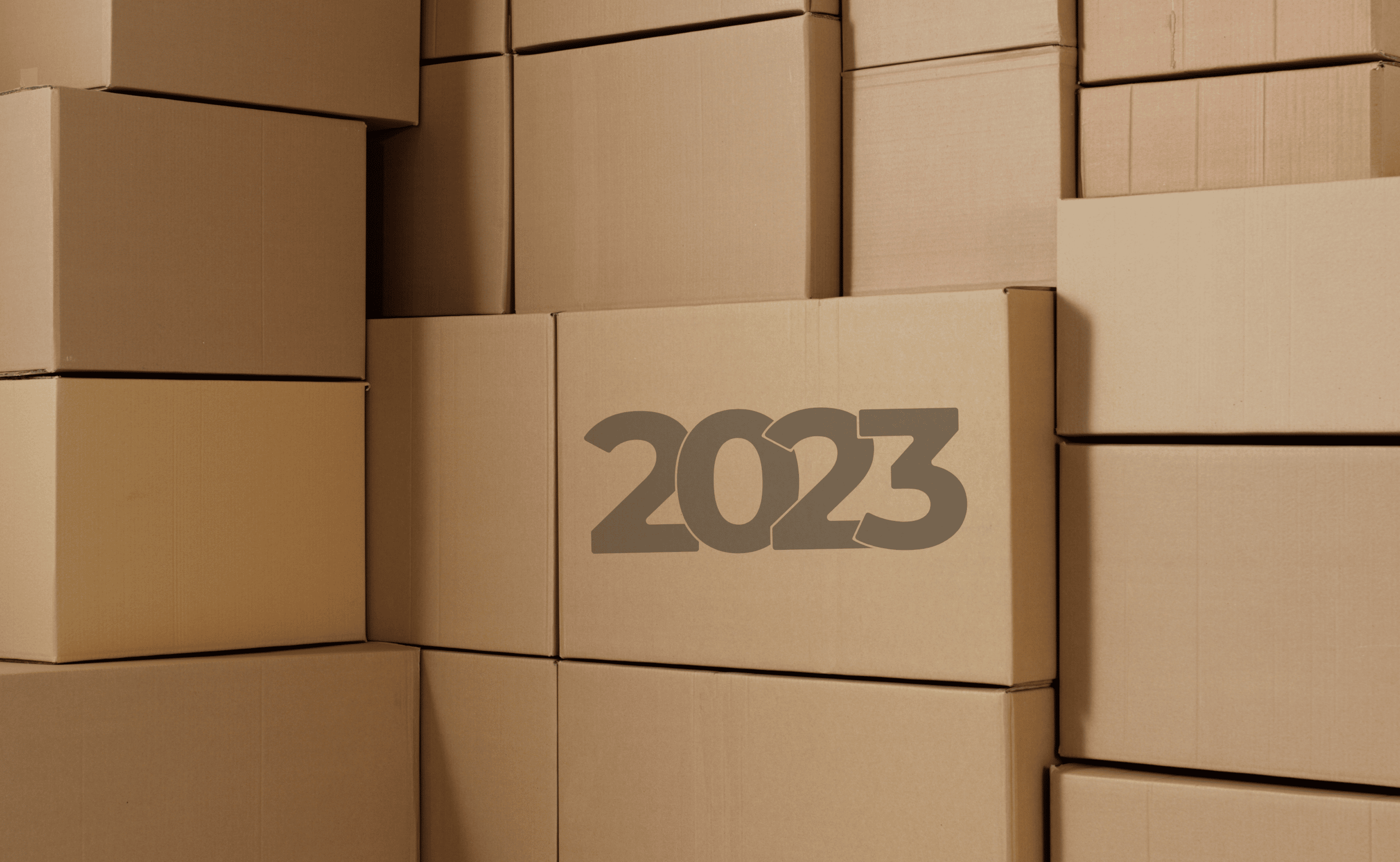Packaging trends to expect in 2023

As we approach the end of another year, it’s time to think about what could happen in the next one!
The packaging industry is a fast-paced environment, so we’re turning our heads to the packaging trends to expect in 2023. What will the latest packaging trends be? Are there any sustainable packaging trends to watch out for?
In this article we’ll consider what happened in the packaging industry during 2022, as well as the economic and social trends happening now that will impact the packaging trends we expect next year.
Blog Contents
- 1.
- 2.
-
3.
Packaging trends to expect in 2023
- 3.1.
- 3.2.
- 3.3.
- 3.4.
- 4.
- 5.

Reviewing what happened in packaging during 2022
The start of 2022 was all about the impending introduction of the UK Plastic Packaging Tax. As businesses prepared for the tax to come into force in April 2022, we saw a flurry of recycled content and plastic-free packaging products enter the market, with more and more business opting for them. (See trend 2 from our 2022 packaging trend predictions!)
At the start of summer we launched our 7th annual unboxing survey, which saw over 1,000 consumers give us their opinions on the packaging used by online retailers. The research highlighted how much ecommerce packaging has changed over the last seven years and emphasised how sustainable packaging materials and custom packaging should be key considerations for businesses using packaging.
In fact, 27% of consumers said they won’t buy again from retailers who don’t use sustainable packaging and 41% said that branded packaging can influence their repeat purchase decisions.
The latter half of the year saw the Environmental Packaging Summit take place at the Coventry Building Society arena. Experts from around the industry gathered to provide updates on Extended Producer Responsibilities, which are set to impact businesses that manufacture, import and distribute packaging, as well as brands that use packaging in the not too distant future. The summit also stressed how critical carbon reduction is as a baseline for lessening packaging’s impact on the planet.

Economic and social trends that will impact packaging in 2023
Life after lockdown – we’re spending slightly less money online
In 2022, we’ve all been adjusting to life after lockdown. This has had an impact on how people are spending, which has been reflected in a slight downturn in online retail sales, with more shoppers returning to bricks and mortar stores compared to pandemic years.
Although it is worth noting that while demand for online shopping is more subdued compared to during lockdown, ecommerce remains a huge piece of the total retail pie. A decade ago, online sales represented 10% of total retail sales, but now accounts for a quarter of all retail sales – well above pre-pandemic years.

UK labour shortages – businesses struggling to fill vacancies
Job vacancies in the UK were at a record high as we entered 2022. The changes to freedom of movement as a result of Brexit meant the labour market was negatively impacted. Lack of viable labour has also been compounded by spikes in early retirement and industry specific impacts caused by the pandemic. This means businesses everywhere have faced recruitment difficulties.
In the high-pressure online retail and logistics sectors, the knock-on effect of this is that it’s harder to be as productive when you do not have a readily available workforce.
The political backdrop – supply chain challenges and rising costs
War in Ukraine and upheaval in Government leadership can’t be ignored either. Businesses are struggling to get raw materials, impacting supply chain continuity and the availability of key products across the nation, and driving up fuel prices – for both vehicles and energy. Inflation is also rising faster than ever, driving up the cost of essentials for everyone.
The result of these social and economic trends is the cost-of-living crisis being faced in the UK. Millions of people are looking to cut spending – both personally and at work.

Packaging trends to expect in 2023
So, thinking about what’s happened in the packaging industry this year, as well as the social and economic backdrop – what packaging trends should you expect in 2023?

1. Packaging cost reduction will be a priority
It should come as no surprise that our first packaging trend is that businesses will be looking to reduce their packaging costs in 2023.
This is particularly important to the retail market, where some 41% of retail employees predict the cost of living crisis will negatively impact non-essential, non-food items for the next couple of years. So, as businesses tighten their belts and try to weather the storm, protecting profits will of course be a priority.
And while many will look at how they can shave pennies off the unit price of their packaging supplies, this may not always be the best tactic. 90% of a business’ packaging costs can be hidden behind the unit price paid.
Taking a holistic approach that considers how packaging can influence many areas in a supply chain, like storage, transport, damages, productivity, administration, and customer experience can yield much higher savings. That’s why we have created tools like the Packaging Optimiser, which will allow businesses of all kinds, including online retailers and third party logistics companies to assess what packaging is really costing them. The Optimiser tool also enables us highlight where and how to cut operational costs associated with packaging.

2. Sustainable packaging and carbon reduction at the heart of packaging strategies
While cutting how much packaging is costing businesses will be critical for many, it shouldn’t come at the expense of improving sustainability.
The climate crisis continues to escalate and that means packaging trend number two is that businesses will need to put sustainable packaging at the heart of their packaging strategies. So, when we look closely at this, what are the sustainable packaging trends?
Well, on the surface lots of online retailers and businesses across the country focus on swapping plastic packaging for paper packing materials. In some ways, this makes a lot of sense – paper is a renewable material and it’s easy to recycle for the end user. But businesses need to look beyond the physical material they’re using and consider the carbon impact of their packaging…
Carbon emission created by human impact on the world are simultaneously driving biodiversity loss and climate change. Biodiversity loss means the planet can absorb less carbon, fueling global warming, which then results in more biodiversity loss. It’s a cycle we need to break and it’s why considering the CO2e of your business’ packaging should be front and centre in 2023.
With this in mind – do you know how much CO2e your packaging creates?
First let’s consider the materials – their weight and how they’re manufactured can all contribute to carbon emissions.
Next, how your packaging is transported – effective palletisation can cut the amount of transport needed to move it, impacting fuel use and emissions. Likewise, if your parcels are optimised for delivery to the end-user as well (i.e. lighter weight, improved dimensional weight etc), this is another carbon saving.
How well your packaging protects your product is crucial too. Damages and returns will instantly push up the carbon cost of transactions, so making sure your packaging protects your products adequately instantly gives you a carbon saving.
All of this is why our previously mentioned Packaging Optimiser can also assess packaging’s carbon impact on your supply chain!

3. Leveraging packaging materials to connect with consumers and gather data for innovation
Marketing Week recently published an e-book about retail trends for 2023 that highlighted personalisation can be a key differentiator for retailers in the coming year. They stated 80% of shoppers are more likely to make purchases where brands offer personalised experiences.
Enter packaging trend number three – connected packaging. Connected packaging is when packaging materials use QR codes or NFC technology to create an interactive (connected) experience for consumers. Most people think about this as an option for primary packaging, but it can work just as well for the protective packaging used for shipping their goods.
The unboxing experience is a critical moment for customers of online retailers, as it’s the first physical interaction with a brand. Connected packaging offers the opportunity to align physical and digital touchpoints and redirect users back to a business’ website.
Connected packaging also offers the opportunity to gather behavioural data when consumers interact with the packaging and the experience that launches. For example, gamification could be used to explain a brand’s sustainability proposition AND help customers earn rewards such as discounts (this is a big driver for UK consumers – 85% report that they desire discounts on future purchases the most!).

4. Digitalisation of packing processes
The fourth packaging trend we expect in 2023 is the continued digitalisation of packing processes.
In short, this refers to the use of robotics and packaging automation to enhance the packing processes businesses are using. For ecommerce and online retailers, as well as the logistics sector, this will be key to overcoming the labor shortages we mentioned earlier.
Packaging automation can also tie into cutting costs for businesses and link back to the first trend mentioned in this article. While the initial investment in automation can seem expensive it can have a direct impact on the overall amount companies spend on packaging materials and labour. The precision offered by automation also allows businesses to optimise parcel sizes or pallet loads more effectively, impacting transport costs too.
Additionally, automated packing processes can help improve productivity and help businesses to future proof their operations for changes in demand further down the line.

Support handling the 2023 packaging trends coming your way
If you need help with your ecommerce packaging (or any type of packaging) in the New Year, Macfarlane Packaging is here to help.
We have packaging design experts on hand to guide you through the journey of optimising your packaging, as well as the tools to prove how we can help you handle the packaging trends we expect in 2023. Get in touch today to see how we can help your business.
About the author – Rachel Fellows
Rachel Fellows is Macfarlane Packaging expert in all things retail and 3PL. As director of National Accounts for the retail industry, Rachel has over 20 years of expertise delivering ecommerce packaging solutions that fulfil the complex needs of online retailers and omni-channel retailers, as well as their 3PL partners.
